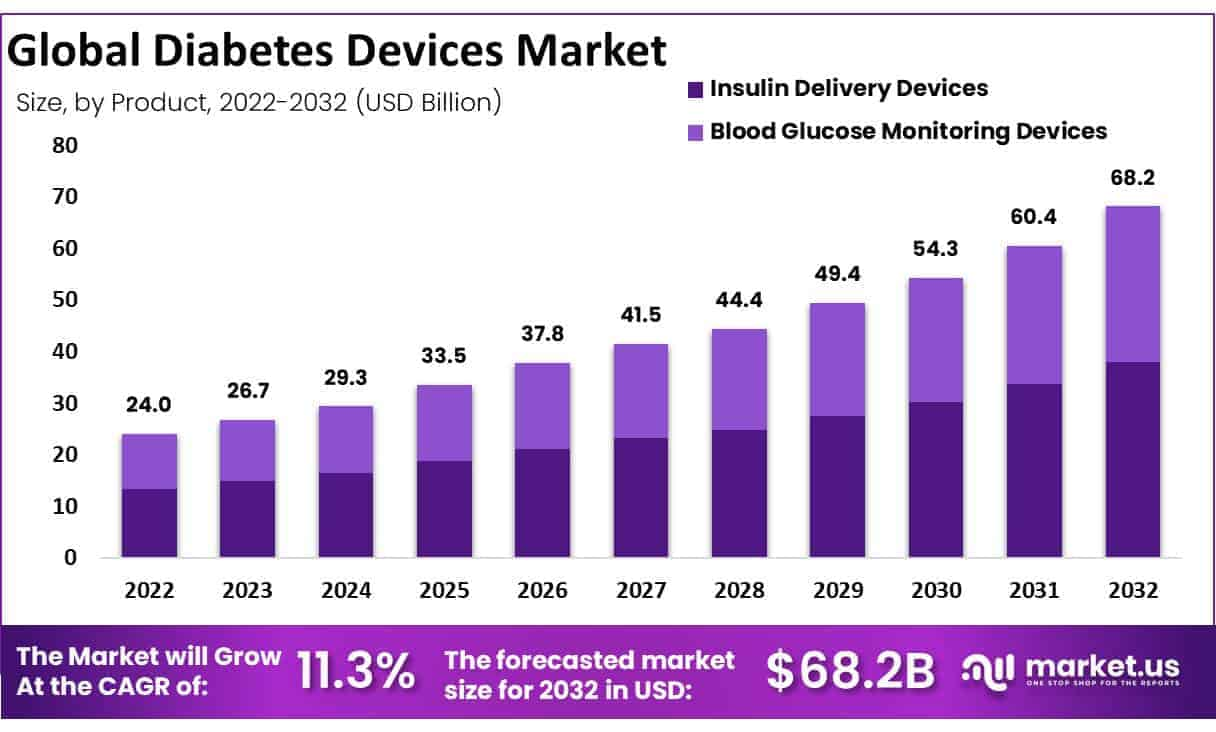Diabetes Devices Market Growth Bolstered by Better Access to Digital Healthcare

The global diabetes devices market is projected to grow from USD 24.0 billion in 2022 to USD 68.2 billion by 2032. This reflects a strong compound annual growth rate (CAGR) of 11.3% over the forecast period. A major driver of this growth is the rising number of people diagnosed with diabetes worldwide. According to the World Health Organization (WHO), over 422 million people live with diabetes. Most of them are in low- and middle-income countries. As cases increase, so does the demand for blood glucose monitors and insulin delivery systems.
Rising Awareness and Early Diagnosis Fuel Demand
Public awareness about diabetes management is improving due to efforts by health agencies. Organizations such as WHO and the Centers for Disease Control and Prevention (CDC) promote early diagnosis and regular monitoring. These campaigns encourage the use of devices like continuous glucose monitors (CGMs), insulin pumps, and smart insulin pens. Regular monitoring helps patients manage their blood sugar levels and prevent long-term complications. This growing awareness continues to fuel the global demand for diabetes devices.
Technology and Digital Health Support Market Expansion
Technological advancements are improving the quality and convenience of diabetes care. Many modern devices offer features like mobile connectivity, automated alerts, and data tracking. These digital tools help patients manage their condition more efficiently. Support from regulatory bodies such as the U.S. FDA and the European Medicines Agency (EMA) has also made it easier for new technologies to enter the market. These developments help expand access to advanced diabetes solutions globally.
Health Policies and Youth-Focused Innovations Drive Adoption
Government health policies are playing a growing role in market expansion. In countries like the United States, Medicare covers continuous glucose monitors for eligible patients. This reduces costs and improves access. At the same time, rising diabetes rates among children and teens are increasing demand for age-friendly, pain-free devices. Health organizations like the International Diabetes Federation (IDF) have raised concerns about this trend, leading to further innovation and investment in pediatric diabetes care.

Key Takeaways
- Growing Diabetes Cases Fuel Demand : Experts note a sharp rise in diabetes cases globally, driving high demand for monitoring and management devices across all age groups.
- Tech Innovations Boost Device Efficiency : Recent advancements have made diabetes devices more accurate and easier to use, especially in glucose monitoring and insulin delivery systems.
- Personalized Care Gains Momentum : Healthcare professionals highlight how modern devices now offer personalized treatment, enabling more precise and patient-specific diabetes management strategies.
- Wearables Revolutionize Monitoring : Wearable devices have gained popularity for offering continuous glucose monitoring and discreet insulin delivery, improving patient comfort and daily life integration.
- Intense Market Competition Emerging : The market is becoming fiercely competitive, with major firms like Medtronic and Roche challenged by startups offering cutting-edge, tech-driven solutions.
GET SAMPLE REPORT : https://market.us/report/diabetes-devices-market/request-sample/
Regional Analysis
North America accounted for a major share of 35.4% in the diabetes devices market. This is due to the region’s large diabetic population and favorable reimbursement policies. In the U.S., high per capita income and growing healthcare spending are key drivers. Additionally, the widespread presence of fast food chains has led to poor eating habits. Increased consumption of unhealthy foods and sugary drinks is a leading cause of diabetes. These factors continue to fuel demand for diabetes management devices in the region.
Growing health awareness and the rising need for diabetes monitoring devices are also boosting the North American market. Many people are now adopting preventive care measures. This trend is further encouraging the use of modern diabetes devices. In Europe, millions suffer from diabetes, as per WHO data. Lower costs of insulin and related delivery devices make them more accessible. As a result, there is growing demand and increased sales of such devices. These developments are positively shaping the regional diabetes devices market.
The Asia-Pacific diabetes devices market is expected to dominate revenue share during the forecast period. This is mainly due to the rising number of diabetic patients. Governments in countries like India and China are supporting healthcare expansion. The region is also witnessing higher approvals of advanced blood glucose meters. There is a strong need for insulin delivery devices across urban and rural areas. These factors are helping drive regional growth. Rising awareness and growing access to healthcare are also influencing market expansion.
Latin America, the Middle East, and Africa are projected to grow at a significant CAGR. This growth is linked to increasing healthcare investments and a growing diabetic population. Access to diabetes care is improving across many nations in these regions. Public health programs and awareness campaigns are also making a difference. The adoption of portable and cost-effective monitoring devices is increasing. As the demand rises, international players are entering these markets. These changes are expected to accelerate the regional diabetes devices market growth.
Conclusion
In conclusion, the diabetes devices market is growing steadily due to rising awareness, better healthcare access, and continuous technology upgrades. More people are being diagnosed with diabetes, leading to higher demand for monitoring and insulin delivery tools. Supportive government policies, increasing use of digital health solutions, and growing interest in personalized care are also boosting adoption. Wearable and smart devices are making diabetes management easier and more comfortable. As health systems across the world invest in early diagnosis and care, the use of advanced diabetes devices will continue to rise. This strong global demand, combined with innovation, is expected to shape the future of the diabetes devices market.
- Art
- Causes
- Crafts
- Dance
- Drinks
- Film
- Fitness
- Food
- Jeux
- Gardening
- Health
- Domicile
- Literature
- Music
- Networking
- Autre
- Party
- Religion
- Shopping
- Sports
- Theater
- Wellness


